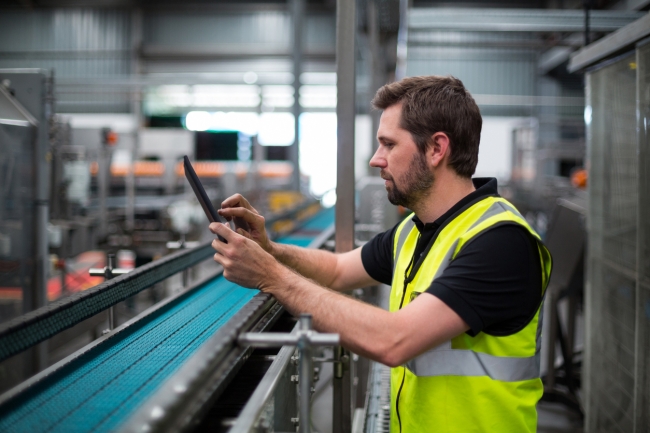5 minute read • published in partnership with Cimlogic
Insight: The benefits of achieving real-time visibility for increased performance and competitiveness
Managing the impact of a global recession, whilst tackling ongoing supply chain disruption, labour shortages and increased energy costs are forcing manufacturing organisations to explore innovative ways to address business challenges. Cimlogic looks at how leading manufacturers, looking to improve operational efficiencies, secure long-term growth and remain competitive are investing more in digital technology such as MES, SCADA/HMI, Predictive Maintenance, Simulation/Digital Twins, and Edge to Cloud.
Manufacturers will benefit from the added power of data from these technologies, to provide greater insight for operational improvements. According to the Make UK report* 74% of manufacturers surveyed viewed increasing capital investment as critical to improving productivity, particularly in processes to increase capacity, improve quality and reduce costs. As detailed in the report, ‘Manufacturers will be investing more in software, acquisitions, new facilities, net zero, and expanding internationally too as they seek to fulfil their wider growth ambitions to accelerate digitalisation, transition to net zero and tap into new global markets’.
Despite current uncertainty, manufacturers recognise that investment is essential to boosting growth, improving productivity, and remaining competitive in a global market. As we all know, the manufacturing landscape is changing rapidly, and tomorrow’s manufacturing leaders need to be ahead of the game today. Demand for new products (and reduced lead times) shows no sign of slowing, and customer relationships rely on fast, efficient, ‘on-demand’ delivery.

Investing in digital technology to support increased visibility of assets enables manufacturers to address the root cause of business challenges – often a more efficient and cost – effective alternative to investing in new facilities or machinery / Picture: Getty/iStock
World-class manufacturers measure and monitor an agreed set of KPIs and use these to evaluate business performance and as input to decision-making. Traditional metrics such as OEE (Overall Equipment Effectiveness) and downtime are valid but have limitations when it comes to evaluating overall manufacturing efficiency and productivity. Driving continuous improvement throughout the entire manufacturing process requires additional KPI metrics factoring all areas that affect productivity, resulting in increased visibility.
The following are the top 7 benefits of achieving real-time manufacturing visibility in your business for increased performance and global competitiveness.
1 – Utilise real-time data for actionable improvement
Measuring OEE is a great building block for implementing Digital LEAN and performance improvement initiatives. The data presented in a performance system must be acted upon quickly, otherwise, production managers will find it difficult to uncover the root cause of problems. Shop-floor teams are encouraged to use the data to uncover reasons behind process inefficiencies to drive improvement, which creates a culture of continuous improvement, as operators become actively engaged with the system and see the value gained from it.
2 – Ensure regulatory compliance & quality
Real-time visibility of quality issues such as non-conformance events or when a process is trending out of control is imperative to achieve improved yield, reduced production waste and avoiding costly product recalls. The impact of product recalls on brand reputation can be immensely damaging and the associated costs/heavy fines (not just production) can be huge. Understanding process capabilities throughout the manufacturing plant are vital to reducing the cost of poor quality, facilitating continuous improvement and carving out a sustainable competitive advantage.
3 – Manage energy consumption
As the cost of energy continues to rise to unprecedented levels and energy contracts come up for renewal, business owners will be concerned about how to manage their rising energy bills and reduce energy consumption. Measuring and monitoring energy usage in real-time, not through monthly or quarterly energy bills, empowers corrective action across the board. Also, identifying improvement opportunities by integrating both energy and production data together encourages proactive energy reduction! Not forgetting the importance of achieving long-term sustainability and carbon reduction targets – another benefit of implementing digital technologies to support energy reduction goals. Cimlogic helped a client in the consumer-packaged goods sector gain insight into energy consumption for strategic decision-making. As a result, they saved approximately £200k in energy costs in just 4 months.

Manufacturers will benefit from the added power of data from digital technologies, to provide greater insight for operational improvements / Picture: Getty/iStock
4 – Reduce production losses
Availability losses such as planned or unplanned downtime, machine setup time, inventory turns, and changeover times all impact OEE and performance negatively. Crucial information such as the effect of non-productive tasks (e.g. sanitising and labour changeover), when a machine went down and the impact it had on the rest of production is however less accessible. Identifying inefficiencies throughout the production process is essential in providing the real-time information needed to take corrective action.
5 – Optimise maintenance activities
Unscheduled maintenance results in lost production, higher part costs, and lost time for fixing problems; costing significantly more than planned maintenance. Adopting a more proactive, preventive maintenance approach to coincide with planned production downtime significantly reduces costs. Preventive maintenance needs to be controlled and managed effectively to keep equipment producing consistently high-quality product. Visibility into equipment availability and performance rates can help reduce unplanned downtime to optimise maintenance activities and gain maximum value from assets.
6 – Understand labour costs
Having the right amount of people and a balance of skills on the shop floor is a huge juggling act! Too few will cause bottlenecks and result in missed production deadlines, too many will create unnecessary labour costs impacting profits. Having access to detailed labour information such as how many staff are needed on lines, required skill sets, and how long it took to complete a job will help paint a picture of your labour requirements. Likewise, understanding how efficiently the workforce is performing against output, how profitably jobs are running and realising the true cost of labour are important factors to consider when optimising workforce performance and ensuring maximum productivity.
7 – Reduce cost of goods
Most manufacturers include direct materials, labour and overheads when evaluating costs. An understanding of all three is needed when trying to reduce the cost of goods, which can contribute to bottom-line KPIs in the business including increasing profit margin, ensuring business sustainability, and increasing customer satisfaction. Increased visibility through digital technology and real-time data analysis, can lead to reduced cost of goods.
Helping our clients gain real-time visibility of operations
Investing in digital technology to support increased visibility of assets enables manufacturers to address the root cause of business challenges – often a more efficient and cost-effective alternative to investing in new facilities or machinery. Cimlogic works with clients on their digital transformation journey to understand the key business drivers and recommend the best solutions to deliver tangible business value – helping define and achieve manufacturing KPIs for increased visibility.
Discover how Cimlogic helped their client, WaterWipes gain real-time visibility of operations needed to drive actionable improvement for optimised production and increased capacity. Read the full case study here: Water Wipes Case Study
